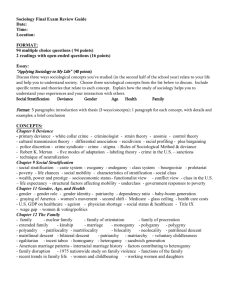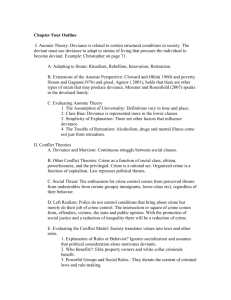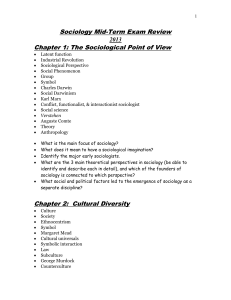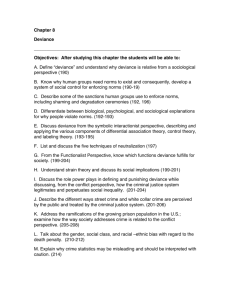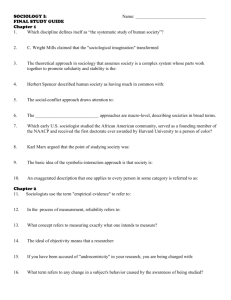1 SOCIOLOGY 100 (005) – STUDY HANDOUT FOR QUIZ #5 Quiz
advertisement
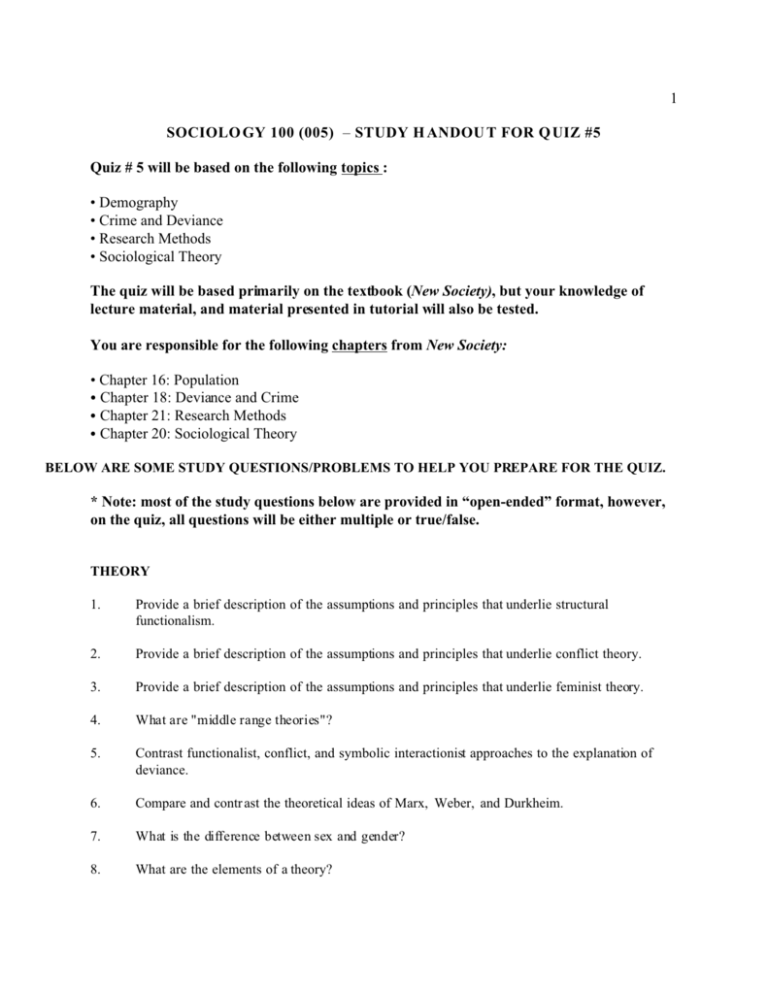
1 SOCIOLO GY 100 (005) – STUDY H ANDOU T FOR Q UIZ #5 Quiz # 5 will be based on the following topics : • Demography • Crime and Deviance • Research Methods • Sociological Theory The quiz will be based primarily on the textbook (New Society), but your knowledge of lecture material, and material presented in tutorial will also be tested. You are responsible for the following chapters from New Society: • Chapter 16: Population C Chapter 18: Deviance and Crime C Chapter 21: Research Methods C Chapter 20: Sociological Theory BELOW ARE SOME STUDY QUESTIONS/PROBLEMS TO HELP YOU PREPARE FOR THE QUIZ. * Note: most of the study questions below are provided in “open-ended” format, however, on the quiz, all questions will be either multiple or true/false. THEORY 1. Provide a brief description of the assumptions and principles that underlie structural functionalism. 2. Provide a brief description of the assumptions and principles that underlie conflict theory. 3. Provide a brief description of the assumptions and principles that underlie feminist theory. 4. What are "middle range theories"? 5. Contrast functionalist, conflict, and symbolic interactionist approaches to the explanation of deviance. 6. Compare and contr ast the theoretical ideas of Marx, Weber, and Durkheim. 7. What is the difference between sex and gender? 8. What are the elements of a theory? 2 CRIME AND DEVIANCE 9. What role did music play in the lives of the subculture studied by Baron? 10. What term did Merton use to describe the lack of fit between cultural goals and social-structural opportunities? 11. Most crime has a class basis. In other words, victims and criminals tend to come disproportionately from particular social classes. Explain. 12. Describe control theory. 13. Describe differential association theory. 14. Which area of Canada has the highest crime rate? 15. Describe Durkheim’s functional analysis of punishment. 16. Are there gender differences in crime and deviance? Explain your answer. 17. According to Aaron Doyle, in what ways do media distort crime? RESEARCH METHODS 18. Name one advantage of self-administered questionnaires over interviews. 19. Name three essential features of the classical experimental design. 20. In terms of measurement, what does validity refers to? 21. Name three types of longitudinal research design. 22. What is the difference between a dependent and an independent variable? 23. List and define three measures of dispersion (or variation). 24. List and define three measures of central tendency. 25. A spurious relationship is: ____________________________________________________ 26. Guppy lists some conditions that need to be met in order to establish causality. What are these? 27. What is external validity? 3 DEMOGRAPHY/POPULATION 28. If one were to analyze the impact of income and education on the number of births, one would be treating fertility as a. a dependent variable. b. an independent variable. c. a dummy variable. d. an intervening variable. e. a background variable. 29. Which of the following groups would be most likely to support the slogan "development is the best contraceptive"? a. Marxists b. Malthusians c. environmentalists d. "right to life" advocates (opponents of abortion) 30. Which of the following has traditionally been viewed as the level of replacement fertility? a. 1.7 births b. 2.1 births c. 3.5 births d. 4.1 births 31. According to Peter Blau, in consider intergroup ties between large and small groups: a. small groups will tend to have lower rates of integration to larger groups. b. large groups will tend to have lower rates of integration to smaller groups c. group size is irrelevant to intergroup integration d. Small groups and larger groups will have equal levels of intergroup integration because they are linked to one another.

